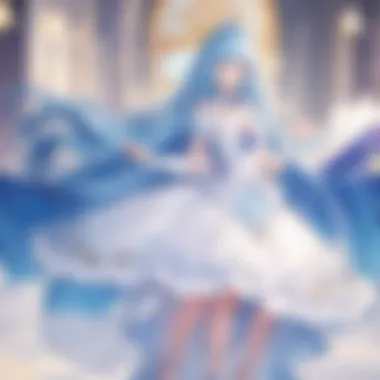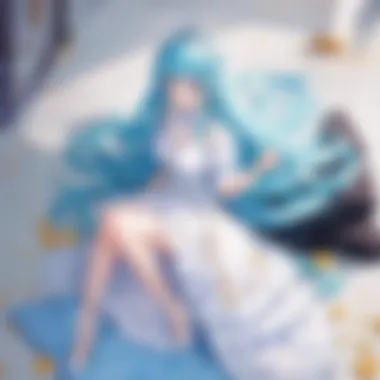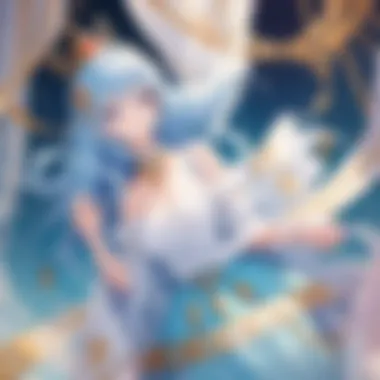In-Depth Exploration of 'Who Made Me a Princess' Webtoon


Intro
In the realm of webtoons, Who Made Me a Princess stands out as a captivating tale that has garnered a loyal fanbase. The narrative is deeply rooted in themes of rebirth, family, and the quest for identity, all wrapped in a lush historical backdrop. By delving into this series, one can uncover the intricate layers of character development and thematic depth that contribute to its popularity.
This analysis will explore multiple aspects of the webtoon, providing a comprehensive understanding for both newcomers and seasoned enthusiasts. A detailed look at the narrative structure, character arcs, and cultural influences will reveal why this story resonates so profoundly with audiences.
Featured Series or Manga
Overview of the Series
Who Made Me a Princess is a webtoon that follows the journey of a young woman who finds herself reincarnated as the princess of a kingdom. The plot unfolds as she navigates the complexities of royal life, grappling with her new identity while trying to avert the tragic fate foretold for her character. This reinvention of a familiar trope breathes new life into the narrative.
The artwork of the series complements the storytelling effectively. The visual style not only draws the reader in but also underscores the emotional nuances within the story. This webtoon combines rich illustrations with a compelling narrative, creating a harmonious blend that captivates the audience.
Key Characters and Development
The character roster in Who Made Me a Princess is diverse and well-crafted. Each character is integral to the plot, contributing to the unfolding drama and emotional stakes.
- Athanasia: The protagonist, navigating her royal life with wit and determination.
- Claude: The enigmatic emperor, whose relationship with Athanasia is central to the story.
- Duke: Athanasia's loyal protector, showcasing themes of friendship and loyalty.
As Athanasia evolves throughout the series, her growth is reflective of the internal and external conflicts she faces. The tension between her past life and her present circumstances drives the narrative forward, making her journey relatable on many levels.
Character Analysis
Major Characters
A more in-depth understanding of the characters enhances appreciation for the story. Athanasia's character offers a glimpse into the trials and tribulations of overcoming one's fate. Claude's duality as both protector and potential adversary adds complexity to their dynamic.
Character Arcs and Growth
The arcs within the webtoon highlight significant changes that characters undergo as the plot progresses. Athanasia starts as a naive figure and gradually matures, learning from her experiences. This growth is not singular; other characters undergo transformations that reflect broader themes of redemption and acceptance.
Thematic Exploration
Main Themes and Messages
Central themes in Who Made Me a Princess include the struggle for identity, familial bonds, and the quest for belonging. The story examines how the characters grapple with their roles within the palace and their inherent desires. Athanasia's journey illustrates the importance of self-discovery amidst societal expectations.
Cultural Context and Influences
Understanding the cultural influences of Who Made Me a Princess adds another layer to its analysis. The webtoon draws from traditional tropes found in fairy tales and historical narratives, all while blending modern storytelling techniques. This synthesis makes it relatable to a broad audience, inviting discussions about gender roles and self-empowerment.
"Art and story can reach across cultural divides, enriching the viewer's experience by highlighting universal themes."
In summary, Who Made Me a Princess is a nuanced work that deserves a thoughtful examination. As we unpack its rich tapestry of narrative and character, the significance of this webtoon within the broader context of manga and anime becomes increasingly clear.
Foreword to 'Who Made Me a Princess'
Understanding the significance of 'Who Made Me a Princess' goes beyond mere enjoyment of storytelling; it reflects deeper themes embedded in popular culture. This webtoon has captured the attention of a wide audience, making it an essential subject for analysis. Readers often find themselves drawn to its blend of fantasy and emotional depth, which resonates on multiple levels. Examining this webtoon allows for an exploration of character dynamics, narrative techniques, and the broader implications of its success in the digital medium.
Overview of the Webtoon
'Who Made Me a Princess' is a compelling webtoon that combines elements of fantasy, romance, and drama. The story follows the journey of a young girl, Athanasia, who is reborn as a princess in a fictional realm. As she navigates her new life, she faces challenges and discovers her place in a world filled with intrigue and danger. The unique premise of being reincarnated into a story offers a playground for exploring themes of identity and choice.


Readers are introduced to a rich tapestry of characters, each playing a significant role in Athanasia's development. The art style complements the storytelling, enhancing the emotions depicted in each scene. This visual appeal encourages deeper engagement from the audience, making it more than just a traditional narrative.
Creation and Background
The inception of 'Who Made Me a Princess' is rooted in the creativity of its author, Plutus. This webtoon was first released on the platform KakaoPage in 2017 and quickly gained popularity. The choice of genre and the depth of the storyline reflect Plutus's ability to weave complex narratives. By adapting familiar tropes in innovative ways, the webtoon invites readers to reconsider their expectations of the fantasy genre.
The creation process involved collaboration with artists who contribute both inking and coloring, resulting in a polished final product. The resulting synergy between storytelling and artwork is integral to the webtoon's success and appeal. Understanding this background provides insight into the labor and thought that went into making 'Who Made Me a Princess' a standout in the webtoon landscape.
"The fusion of diverse elements and thoughtful character arcs elevates the narrative to new heights, marking it as a noteworthy contribution to contemporary webtoons."
By delving into the creation and conceptual groundwork of this webtoon, readers can appreciate the intricate design behind its success. As we move forward in the analysis, we will explore the narrative structure, character development, and themes that continue to engage and fascinate audiences.
Narrative Structure
The narrative structure of a webtoon is crucial for shaping the reader's experience. In the case of 'Who Made Me a Princess', the story's organization influences how the plot unfolds and how characters develop. A clear and engaging narrative structure allows the audience to follow the story with ease. This enhances emotional investment, making the experience more immersive. Each element within the narrative framework can lead to deeper connections with characters and their journeys.
Plot Summary
'Who Made Me a Princess' presents a story centered around a modern girl who finds herself reincarnated as a minor character in a fantasy novel. Specifically, she becomes Athanasia, the daughter of a powerful emperor. The emperor is notorious for being ruthless towards his enemies. Athanasia realizes that her character is destined to die at the hands of her father. This knowledge drives her to seek a way to change her fate. The plot weaves through different challenges she faces as she tries to survive in her new life.
Key points of the plot include:
- Reincarnation: The twist of bringing a modern character into a historical fantasy setting.
- Conflict: Athanasia's struggle against her predetermined fate.
- Character Relationships: Interactions with family and other characters, illustrating emotional depth and complexity.
Pacing and Flow
Pacing significantly impacts how the story is perceived. In 'Who Made Me a Princess', the pacing is a blend of fast-paced action and slower, reflective moments. It gives the audience time to process character emotions and motivations.
Important aspects of pacing in this webtoon are:
- Balance of Action and Character Development: Quick sequences of events are interspersed with deeper explorations of Athanasia's psyche.
- Cliffhangers: Strategic use of cliffhangers ignites curiosity and keeps readers engaged, especially at the end of chapters.
Overall, the pacing complements the plot while allowing characters to resonate with the audience. It is effective in inviting readers to reflect on the intricate dynamics of the story.
Character Development
Character development plays a crucial role in making a webtoon resonate with its audience. In the case of 'Who Made Me a Princess', the characters are not merely vessels to propel the plot; they embody themes, values, and emotional arcs that keep readers engaged. A well-crafted character invites the audience to invest emotionally, turning the story into a shared experience. This section explores the protagonist, supporting characters, and the relationships that shape the narrative.
Protagonist Analysis
The protagonist of 'Who Made Me a Princess' is Athy. Her character is layered and evolves significantly throughout the webtoon. Initially portrayed as naive and playful, Athy transforms into a self-aware individual who confronts the challenges of her newfound royal status. This shift is essential in promoting themes of identity and autonomy. Athy's struggles resonate with many readers who face issues of acceptance and self-worth.
Athy's journey is marked by her resilience. She navigates the intricacies of court life while grappling with her previous life as a mere bystander. What sets her apart is not just her royal heritage but her determination to forge her own destiny. By emphasizing her growth, the narrative invites readers to reflect on their own lives and the paths they choose.
Supporting Characters
The supporting characters in 'Who Made Me a Princess' enrich Athy's story by providing contrasting perspectives and aiding her development. Characters like Claude, the emperor, and the diverse cast of nobles draw distinct lines in personality and ambition. Each supports or challenges Athy in unique ways, helping to highlight her traits.
Claude, for instance, serves as both protector and potential threat. His complex nature contributes depth to Athy’s journey, forcing her to confront her feelings of love and betrayal. Other characters, like the courtiers and family members, bring additional layers that create a vibrant court life, creating a dynamic environment where Athy must adapt and grow.
Character Relationships
Relationships serve as significant catalysts for character development in 'Who Made Me a Princess'. The interactions between Athy and other characters illustrate the complexity of human emotions, including love, jealousy, and friendship. Athy's relationship with Claude not only drives the romantic plot but also illustrates her personal growth.


Moreover, Athy's friendships with other princesses and nobles emphasize themes of solidarity and rivalry. These relationships are not without tension, reflecting real-life social dynamics. Ultimately, the webtoon illustrates that relationships can be both a source of strength and vulnerability.\n
"In narratives, character relationships often reflect societal norms and conflicts, making them an essential aspect of storytelling."
The evolution of character dynamics shows that personal connections significantly impact Athy’s actions and decisions throughout the story. This intricate web of interactions enhances the narrative and provides readers with a deeper understanding of the characters' motivations and struggles.
Through Athy and her relationships, 'Who Made Me a Princess' articulates a poignant commentary on the human experience, making the character development vital to its success.
Themes and Motifs
The themes and motifs present in a webtoon can profoundly shape the reader's experience. In 'Who Made Me a Princess,' these elements operate on multiple levels, effectively communicating complex ideas that resonate with audiences. This section will delve into three significant themes: identity and transformation, power and responsibility, as well as love and sacrifice. Each of these key themes not only drives the narrative forward but also mirrors the protagonist's journey as she navigates the challenges of her new life.
Identity and Transformation
At the heart of 'Who Made Me a Princess' lies the theme of identity and transformation. The protagonist, Athanasia, undergoes a profound metamorphosis as she transitions from a regular girl to a princess reincarnated into a royal family. This transformation is marked by her struggles to forge her new identity in a world where her fate is dictated by others. The concept challenges the notion of selfhood; it raises questions about what truly defines a person's identity.
Readers find themselves contemplating the essence of who we are versus who we are expected to be. Athanasia's reluctant acceptance of her princess role highlights the conflict between personal desires and societal expectations. This struggle is integral to the narrative, prompting readers to reflect on their own identities amidst external pressures.
Power and Responsibility
Another major theme explored in the webtoon is that of power and responsibility. In the royal setting of the story, power is a double-edged sword. Athanasia, despite facing dire circumstances, gradually learns to navigate the dynamics of power within her aristocratic environment. The juxtaposition of her innocence with the political intrigues of the court adds depth to the storyline.
Power comes with the responsibility of understanding one's actions and the reactions they incite. Athanasia's journey highlights the various responsibilities that accompany royal status, such as making decisions that impact not only her life but also the lives of others. This theme encourages the audience to ponder the implications of power in their own lives, both in leadership roles and personal relationships.
Love and Sacrifice
The theme of love and sacrifice permeates 'Who Made Me a Princess.' Athanasia’s relationships with other characters illustrate how love can drive individuals to make significant sacrifices. Her bond with her father, the enigmatic and often cold Emperor, is central to the narrative. As she seeks his affection, Athanasia's actions often place her in precarious situations.
In the realm of familial relationships, the expression of love is intertwined with the willingness to endure hardship for others' well-being. The theme evokes an understanding of the sacrifices one makes for love, echoing the age-old sentiment that love can be both nurturing and burdensome. By engaging with this theme, readers gain insight into the complexities of love; it is not always simple or clear-cut.
"The truest form of love requires a willingness to sacrifice, even at personal cost."
Through these themes, 'Who Made Me a Princess' engages its audience in a profound exploration of identity, power, love, and the sacrifices that accompany them. The blend of these motifs not only enrich the narrative but also enhance its relatable qualities, ensuring it resonates deeply with anime and manga enthusiasts.
Artistic Style
The artistic style plays a crucial role in the overall effectiveness and appeal of 'Who Made Me a Princess'. This webtoon uses its aesthetic choices to enhance storytelling, evoke emotions, and draw readers into its world. The visual elements used in this work significantly contribute to character portrayal and scene setting, making them an essential aspect of this analysis.
Visual Presentation
The visual presentation of 'Who Made Me a Princess' is distinctive and skillfully executed. The art style is characterized by delicate lines and expressive features, which provide a sense of elegance and charm. Character designs are well thought out, with each figure reflecting their personality and role in the narrative. For instance, the protagonist, Athanasia, is depicted with large, expressive eyes that convey her innocence and emotional depth. The environments are richly drawn, often adorned with ornate details that complement the story's royal setting.
Additionally, the webtoon employs a balance of detail and simplicity. This strikes a harmony that allows readers to absorb the story without becoming overwhelmed by visual noise. The characters’ movements are fluid, making action scenes engaging while still maintaining clarity and focus. Overall, this approach to visual storytelling significantly heightens the reader's connection to the narrative.
Colors and Imagery
Colors in 'Who Made Me a Princess' serve not only as aesthetic choices but also as narrative devices. The palette is often bright and vibrant, effectively creating a whimsical atmosphere reflective of the fantasy genre. Lighter hues dominate scenes involving happiness and innocence, while richer, darker colors are used during more serious or emotional moments. This strategic use of color enhances the emotional landscape of the webtoon, guiding the audience's reactions and interpretations as the story unfolds.
Imagery further complements the narrative. Symbolic elements, like flowers or weather changes, often emphasize themes or character emotions subtly. For instance, the recurring use of white lilies may symbolize purity or rebirth in Athanasia's journey. Coupling these visual techniques with colors enriches the reader's experience and reinforces thematic depth.
"Art is the most beautiful of all lies."
An analysis of 'Who Made Me a Princess' shows how visual elements shape the audience's understanding and emotional engagement.
Cultural Context


Understanding the cultural context surrounding the webtoon Who Made Me a Princess is essential for grasping why it resonates with its audience. The comic reflects not only trends in storytelling but also societal values and norms that are prevalent within its creation period. The blending of traditional narratives with modern themes allows it to appeal to a wide range of readers.
Popularity and Reception
Who Made Me a Princess has garnered significant popularity since its debut. This vast acclaim can be attributed to several factors:
- Relatability of Characters: The characters have depth and complexity, making them relatable to many readers. Viewers connect deeply with the journey of the protagonist, Athanasia, as she navigates her new life.
- Engaging Storyline: The plot combines elements of fantasy, romance, and drama, keeping readers hooked. The unpredictable twists keep up the suspense, encouraging ongoing engagement.
- Artistry and Visual Appeal: The webtoon's rich visuals and vibrant color palette captivate the audience, enhancing the storytelling experience. Aesthetic factors are crucial in attracting readers.
Reviews often highlight the exceptional character design and vibrant storytelling as defining aspects of the webtoon.
Influence on Pop Culture
The influence of Who Made Me a Princess extends beyond just webtoons. It has left notable marks on popular culture, leading to:
- Merchandising Opportunities: The characters and themes have inspired a range of merchandise, from figurines to apparel, reflecting the webtoon's broad appeal.
- Fan Art and Community Engagement: Online platforms, especially Reddit and Facebook, are buzzing with fan creations, discussions, and theories about character developments and plot twists. This community aspect fosters a deeper connection among fans.
- Inspiration for Other Works: Many creators in both webtoons and traditional manga cite Who Made Me a Princess as an influence, indicating its integral role in shaping new narratives in anime and manga.
"Webtoons like Who Made Me a Princess not only tell stories but also shape the industry, influencing future generations of creators."
As we can see, the cultural context plays a vital role in understanding the impact of Who Made Me a Princess. Its popularity and influence permeate through various facets of pop culture, making it a staple reference for both fans and newcomers alike.
Comparative Analysis
Analyzing 'Who Made Me a Princess' in relation to other webtoons and traditional manga is essential to understanding its unique position within the broader narrative landscape. Comparative analysis allows us to highlight distinctive storytelling elements, artistic choices, and character developments that set this webtoon apart.
By examining such works, we can identify trends in genre, themes, and audience reception. This understanding benefits not only enthusiasts looking to deepen their appreciation but also creators and researchers interested in the evolution of webtoons and manga. Ultimately, this analysis can uncover how 'Who Made Me a Princess' resonates with audiences and contributes to cultural dialogues surrounding fantasy storytelling.
'Who Made Me a Princess' vs. Other Webtoons
When we place 'Who Made Me a Princess' alongside other popular webtoons, several distinctions emerge. For instance, many webtoons often follow a single narrative arc focused solely on romance or adventure. In contrast, this webtoon incorporates a rich blend of various elements, including humor, conflict, and deeper themes of identity and transformation.
Additionally, the pacing in 'Who Made Me a Princess' strikes a careful balance. While certain webtoons rush through character development, this series invests time in building its characters, creating complex relationships that enhance emotional engagement. The art style also differs from typical industrial webtoons, favoring a more detailed and colorful approach that enhances the storytelling experience.
This allows readers to connect with the characters on a personal level. As a result, 'Who Made Me a Princess' garners a dedicated following, drawing in readers who appreciate a more layered and nuanced story structure.
Crossover with Traditional Manga
The crossover of 'Who Made Me a Princess' with traditional manga demonstrates a fascinating intersection within the storytelling medium. Both forms share similarities in exploring fantastical elements and character-driven narratives, yet they diverge in presentation and pacing. Manga typically requires longer episodes to expand on character arcs, while webtoons often have concise chapters that push the story forward quickly.
This webtoon, infused with vibrant colors and expressive art, appeals to a different audience than traditional manga, yet still embraces core themes familiar to manga fans. The character designs often reflect an exaggerated style common in shoujo manga, but they are presented in a digital format, making them accessible globally.
Closure
The conclusion serves as a vital component in this analysis of 'Who Made Me a Princess.' It encapsulates the key findings and provides a broader context for the themes and character development discussed throughout the article. Summarizing the narrative structure and the unique artistic style, the conclusion underscores how these elements together contribute to the webtoon's immense popularity.
Summary of Findings
Through our exploration, several important points emerge:
- Narrative Complexity: The series utilizes a well-structured plot that intertwines various character arcs with depth. This complexity fosters emotional engagement.
- Character Dynamics: The protagonist, Athanasia, experiences significant transformation, which reflects broader themes of identity and agency. Supporting characters add to the richness of the narrative, offering diverse perspectives that enhance the storytelling.
- Visual Aesthetic: The webtoon’s art style is characterized by vivid illustrations and effective use of color, which complement the emotional undertones of the story. This visual presentation plays a crucial role in engaging the audience.
- Cultural Impact: The reception of the webtoon reflects its resonance with contemporary issues in society, such as the pursuit of individual identity and the interplay of power dynamics in relationships.
This synthesis of findings illustrates how 'Who Made Me a Princess' is more than just an engaging story; it is a reflection of cultural themes that speak to a broad audience, navigating complex emotional landscapes.
Future Implications
The implications of this analysis extend beyond the webtoon itself. As 'Who Made Me a Princess' continues to gain traction, it opens avenues for further exploration within the webtoon and manga industry.
- Cultural Dialogue: The themes presented may prompt discussions regarding identity and personal agency, making it a relevant piece in academic and cultural studies.
- Influence on Future Works: Its success could inspire other creators to explore similarly rich narratives and character developments, potentially shaping future content in the genre.
- Market Trends: As webtoons gain popularity, understanding the metrics of their success will help both publishers and creators in charting future projects. This could influence not only storytelling but also marketing strategies within the industry.
In summary, the conclusion not only ties together the thematic elements but also points to the forward trajectory of content creation in the realm of webtoons, ensuring that the relevance of 'Who Made Me a Princess' will echo in future creations.



